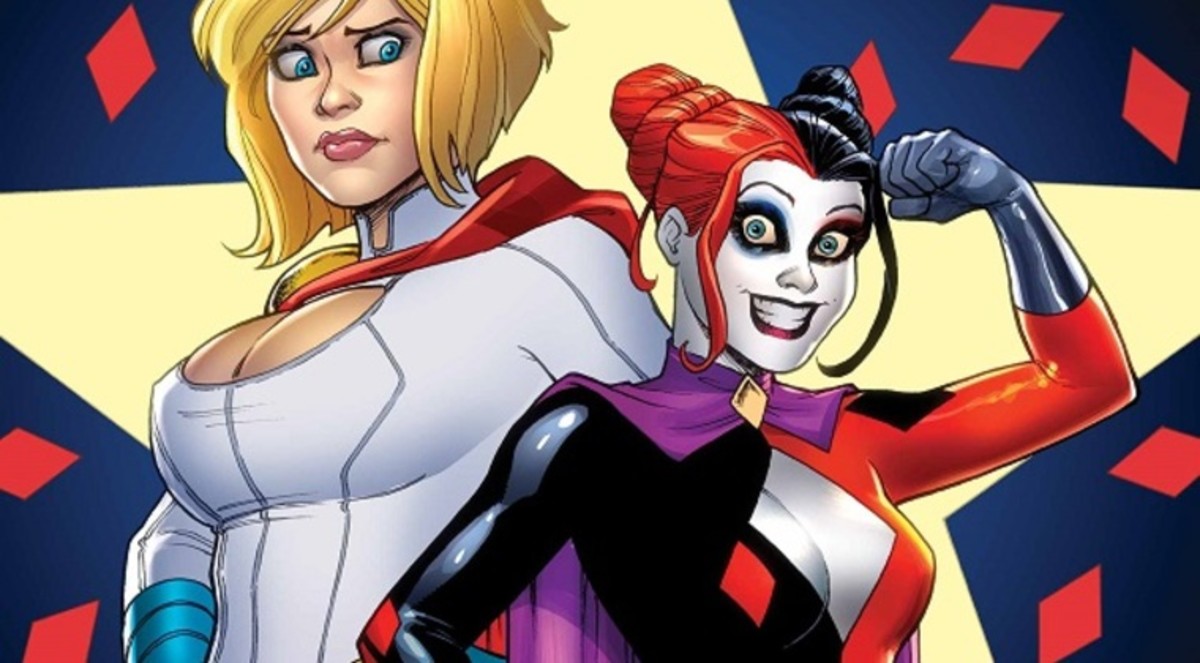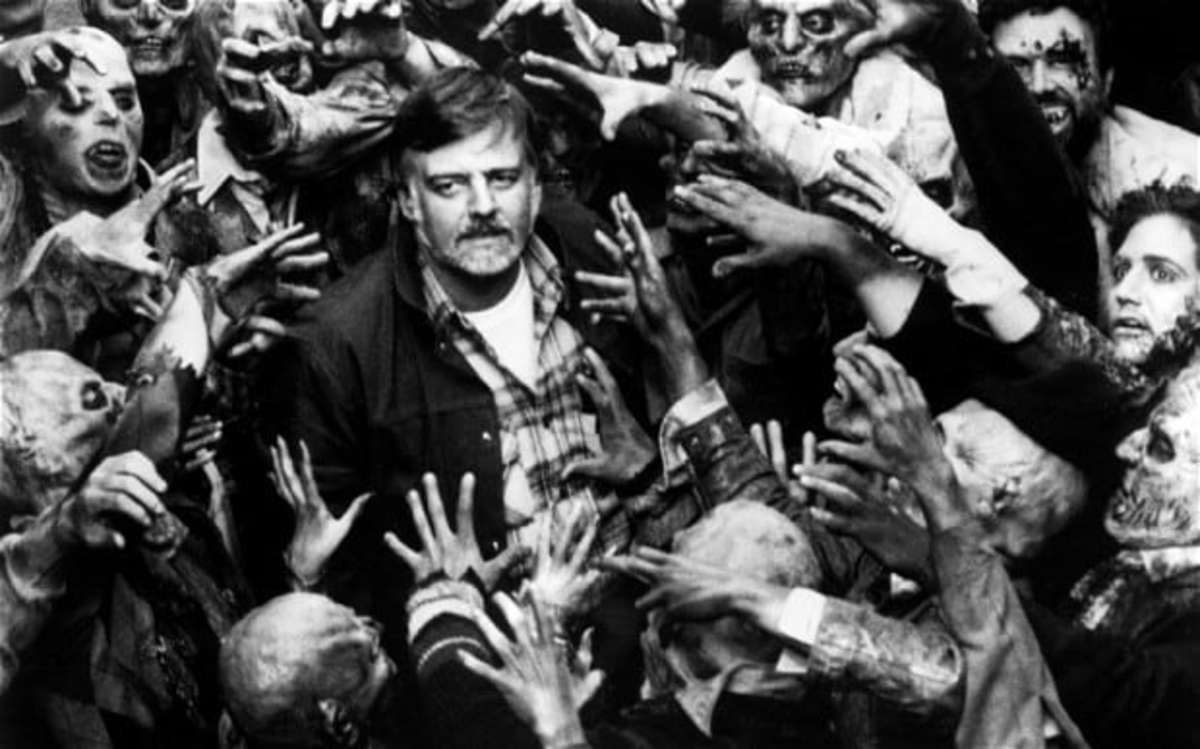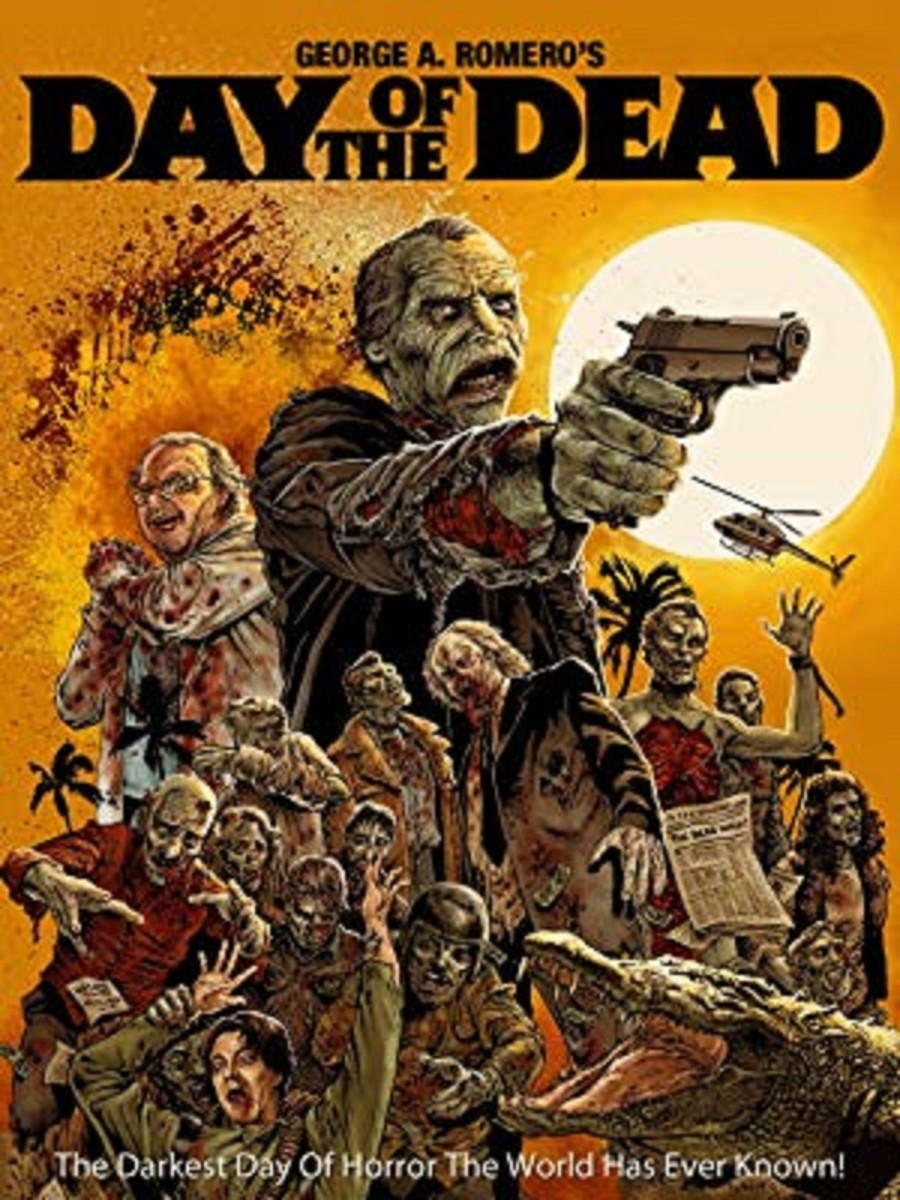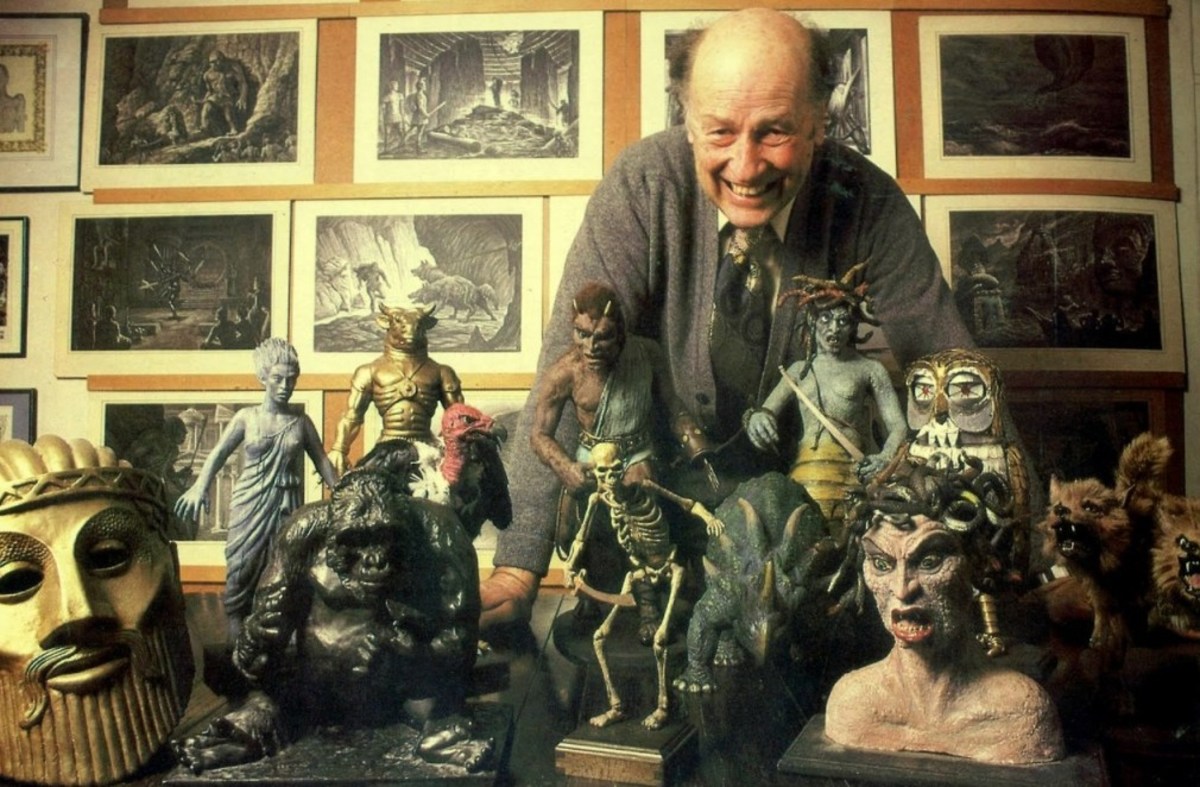Feminist Film Theory: Analysis Of Romero's 'Living Dead' Films.
Contents:
- Introduction to Feminist Film Theory
- Romero's 'Living Dead' Trilogy
- Gender Representations in Romero's Film's
- Can Romero Be Considered A Feminist Film Maker?
- References
- Video- 'Day of the Dead'
- Links to More on Film Theory
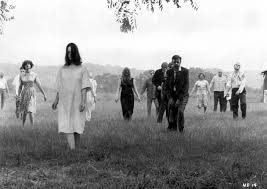
Introduction to Feminist Film Theory
Cinema has been seen by feminists to be a social practice that embodies myths about women and femininity. Early feminist criticism was focussed on stereotypes of women mostly seen in Hollywood films. These films would see women as submissive, quiet and ultimately helpless. The horror genre was no different. The terrifying worlds we see in horrors films is rarely kind to women. Women would be portrayed as hysterical, frail and powerless, women that would not survive except for the help of men. The horror genre usually caters to the demands of young teenage boys throwing plenty of blood, torture and attractive, naked women into the films. These fixed and constantly recurring images of women are considered by feminists to be offensive and intolerable misrepresentations that would have a negative influence on the female viewer. Director George A Romero transformed the zombie film industry with his ‘Living Dead’ films, being the first to portray zombies as human beings and not as monsters. He wanted to portray how these ‘beings’ were once human and they should be treated like such, not as animalistic fiends. Romero provides a visual rendering of cinematic torment and destruction with the only character content at not becoming a narcissist being a woman. In so many horror films we have seen women is distress but Romero places his female leads in environments where they are alone, surrounded by patriarchal men and yet, survive regardless of this.
In regards to Hollywood films that pigeon hole the female character, Anneke Smelick says in her essay ‘feminist Film Theory’ that “women are represented as ‘not-man’” (Smelick, 2007). She argues that as viewers we must understand that cinema echoes reality, constructing only an ideological view of reality. Classic cinema does not show it’s means of production and this is considered as cloaking it’s ideological composed images of ‘women’ as effortless, realistic and attractive which is just an illusion of classic cinema. The narrative structure of classic and traditional cinema ascertains the male character as active and powerful simply because they are male and the female characters as submissive and powerless and merely as an object of desire for male characters. Smelick also says that in this respect “Cinema has perfected a visual machinery suitable for male desire such as that already structures and canonized in the tradition of western art and aesthetics” (Smelick, 2007). She concludes that while feminists need to deconstruct the patriarchal images and representations of women, they historically need to establish their female subjectivity at the same time. Essentially they need to redefine what it means to be a woman. Romero does exactly this in his ‘Living Dead’ films. These films contain Romero’s most remarkable representations of effective and sometimes aggressive women. While the Hollywood films typically eroticized and naturalized male violence while emphasizing female passivity, Romero was using his zombies to undermine this conjecture.
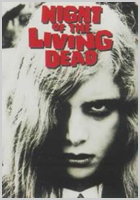
Romero's 'Living Dead' Trilogy
In order to analyse Romero as a feminist we must first look at his female characters and how they are characterized on screen. Looking at the first of the series, ‘Night of the living Dead’ (Romero, Night of the Living Dead, 1968)it is clear throughout that the female characters become increasingly more involved in decision making process as the films develop. The film follows the dilemma of a group of strangers huddled up together in a deserted farmhouse as they try to barricade themselves in from a mass of walking zombies outside. The first character we are introduced to is Barbara, placing a wreath on her father’s grave with her brother Johnny, she is attacked by a zombie. She screams for help and all she can do is wait for Johnny to defend her. Johnny is killed as Barbara sits back helplessly. She is rescued by men and brought back to the farmhouse where she becomes deranged and hysterical with fear. She is oblivious to her surroundings and mumbles and rants about nonsensical rubbish. At first glance it may seem that Romero is giving in to the classic models of horror genre females, but one must assess how he deals with the men in the society to which his female characters are cast. The male characters back at the farmhouse are fighting over their best chances of survival, while the women tend to their sick and stay out of the decision making process. The three men hold the discussions about what needs to be done to survive without consulting the women about what they think, they’re opinions do not come into play. This point is revealed when Tom ignores the women standing in the room and tells Harry and Ben, “We’d all be a lot better off if all three of us were working together.” The men of ‘Night of the Living Dead’ genuinely see themselves as the only people there capable of being realistic and logical enough to organize a successful escape and ultimately, achieve they’re survival. Romero portrays how the female role is made useless only by the male roles taking on full control. Without their narcissistic views on being better and smarter than women, the feminist issues of female portrayals would not be noticed.
In looking at ‘Dawn of the Dead’ (Romero, Dawn of The Dead, 1979) and the female lead character it is obvious from the outset that she is a strong, intelligent woman and also, that Romero is progressively empowering his female leads. Fran is a figure of authority at a Television production company and one that has the last say as to what goes on air. She is the ideal role model for feminists in this respect. The collective shrieks of disorganised journalists set the pace for what Fran has to deal with in a patriarchal society. She is composed and calm and immediately responsive to the aggressive situation. Two correspondents argue back and forth on air as they debate the condition of the zombies. Nobody appears to know what their job is or what they should do, papers are scattered and flying in the air and Fran is the only person in the room that looks in control. This is how we are introduced to Fran, hinting a more feminist approach to filmmaking. Romero is giving his female characters increasing independence and resourcefulness through Fran. He does this also through his female zombies. They are un-dead and practically un-gendered, being responsible for as many violent and gruesome acts as the male zombies. According to Stephen Harper in his essay ‘”They’re us”: Representations of Women’ the cruelty and viciousness of the female zombies “makes for uncomfortable viewing from a patriarchal perspective, but it crucially prepares for representations of human women as active and even violent agents” (Harper).
Harper also states that when Fran says “They’re us” she’s proving the moral intricacy of the zombies, “as mobilized for feminist purposes” (Harper). By implying that zombies are not wholly evil and animalistic, Romero in encouraging a varied conception of what it means to be a woman. Using a varied group of zombies from different social backgrounds, races and ages, we are being shown a distinct understanding of the human-zombie relationship, one that only Fran understands, unlike her aggressive male counterparts. This is most notable in the scene where she sits opposite a glass door looking compassionately at a zombie in a baseball uniform. It is the same look she gives Roger as he is being pushed around the mall in the cart, of a mother looking in lovingly at her chid in a pram. Fran’s nurturing disposition is emphasized here and suggests her strong capacity for the conventionally feminine qualities. Fran looks at the zombie almost like a child which is made even more clear because as he was almost born out of a nun-zombie’s dress. While she may be an active character, the pregnant Fran empathises with the helpless, infant-like zombie in a way the male characters would find ridiculous. In this sense, Romero is challenging the generalized view that a woman’s sensitivity would have a negative impact on logic and reality. The baseball zombie may be a symbol of Fran’s unborn child, which could explain why she is unafraid of him. This is stressed in the following scenes where we see Fran getting sick due to the pregnancy. Romero is using images of motherhood in order to signal the life-giving potential and nurturing ability of women in the face of male obliteration. Fran helps the men defend themselves against the horde to which Roger gets bitten, but she is also exceptionally expressive and aware of the men’s sexist assumptions of her, portrayed when she says “I’d have made you all coffee and breakfast but I guess I don’t have my pots or pans”. She makes sure she is never left on her own without a gun to defend herself and she asks to be taught how to fly the helicopter in case Stephen is killed. These are ways of empowering herself and ensuring her survival as well as her unborn child’s.
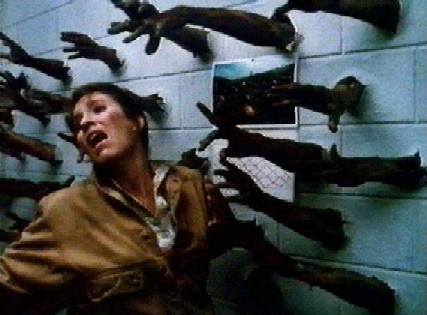
Gender Representations in Romero's Films
When the group, made up of Fran’s lover Stephen and two men -Peter and Roger, first arrive at the mall and experience the wonders of having everything they’ve at the tip of their fingers, Fran appears to be the only one that does not want to take part in the looting of the mall. While she explains her issues about staying at the mall to Stephen, all he has to say is that “we have all we’d ever need” and that they really have ‘it made’ there. Again her opinions aren’t acknowledged by the men who believe they are the ones capable of ensuring survival which shows that the male roles have not progresses throughout Romero’s films. Fran’s attitude gradually changes as the film develops and she becomes entranced with capitalisms appeal and consumerism. She forsakes any concept of empowerment and equality for glamour and make-up. Bewitched by the mall she falls increasingly into the stereotypical ‘female’ patterns of behaviour, pampering herself, wrapping up in fur coats and looking at herself in the mirror. She is becoming more like the vacant mannequins that are displayed throughout and subsequently, the blank zombies that wander around the mall. It is a twist on the Adam and Eve scenario, being that it is the men that give in to the malls attraction and charm rather than the woman. Their greed and gluttony for senseless objects that are useless in a society that has crashed to the point of near extinction almost coasts them all they’re lives. This is clearly shown when Roger and Peter take money from a cash register because “You never know” and when Roger insists on going back into a mass of zombies, putting both their lives in danger, to retrieve a bag he left. There is nothing noteworthy in the bag so why bother going back for it when the mall is full of similar goods? Romero slowly corrupts Roger because of his own immaterial pleasures and it’s because his mind is fixated on having everything it wants, that costly mistakes are made and Roger is bitten by a zombie. It could be said that this is also a stab at macho-masculinity, thinking that because you are male and strong that you will defeat everything that comes your way. Roger certainly displayed these feelings of superiority but also appeared to be treating the situation like a game so it is no surprise that he is the first of the group to go. After Roger’s death, the assumptions of the men are portrayed in a scene where Fran is going about the room making dinner and setting the table while Peter and Stephen drink and play cards. Here the characters have become so comfortable with their surroundings that they have fallen back into their usual habits and routines of treating women like they are underneath them and where the women look after and feed the men. Another way Romero portrays the patriarchal control men have over women in the scene where Fran is in sitting up in bed isolated from the men are talking in another. The men discuss colonising the mall and Stephen tells the two men that Fran is pregnant. They talk about the possibility of her having an abortion, not once taking into consideration that it is ultimately her decision, depicting how masculine authoritative power is implemented not only over women’s social role but over their bodies as well.
Romero also has something to say about the will to live in the film. At two points men are seen pointing a gun to their heads contemplating suicide. Although they never actually go through with it and end their lives, the fact that they considered it shows a lack of will to live in dangerous situations. This never occurs to Fran, taking her own life to save herself from the zombies. This could be due to her pregnancy and the fact that she is not just taking her own life but that of her babies too. Another way to look at it may be that she is more willing to fight for her survival. In this regard she can be considered stronger than the men. The entire film portrays Fran seeking empowerment, and she does this is a number of ways. Firstly she makes sure she is left with a gun at all times since she was attacked the previous time she was left alone and had to wait for the men to arrive to save her life. Asking for the gun proves she knows she can’t rely on the men to constantly rescue her, she is competent enough to do that herself. When she first says this to the men Stephen appears annoyed at the fact that she is willing to protect herself and therefore is not in need of him. She cunningly says that she’s sure she will figure out how to use it and she does. She also asserts the importance of being taught how to fly the helicopter, their only way of escape. Since Stephen does indeed die, it proves her ability to think logically and clearly in grave circumstances where the men were not.
Romero’s female leads progress yet again in his third instalment of the ‘Living-dead’ series ‘Day of the Dead’ (Romero, 1985) when he introduces Sarah. She is a highly intelligent scientist trying to find the cure for the Zombie infection. She does this amid controlling and somewhat crazy men that insist on trying to domesticate and socialize the zombies. Sarah is logical and practical and appears to be the only one willing to conceal individual differences of opinion in order to work together for a mutual goal of mankind’s survival. We quickly discover the trigger happy soldiers are no better than the hordes they hunt and kill, portraying, yet again, that the men of Romero’s films do not improve and advance. Sarah, however, goes one step further than Fran in ‘Dawn’ and shows greater compassion for the zombies, particularly Bub, who is being used as an experiment by the crazy Dr. Logan. She is empathetic and often considerate and gentle towards the captive zombie. Her nurturing disposition towards the helpless creature portrays how Romero views sympathy and caring as an important aspect of survival.
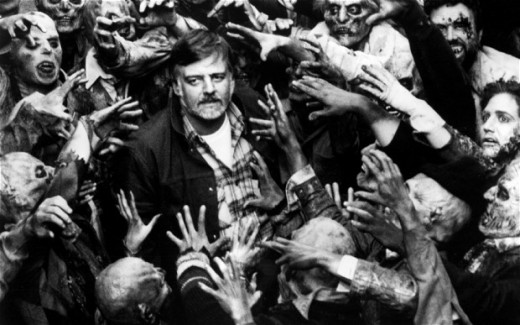
Can Romero be Considered a Feminist Film Maker?
While classic Hollywood and horror cinema stereotyped women to the point of being useless. They were attractive, often stupefied, wailing women that would not survive the nightmarish situation were it not for the men around them. According to feminists these images of women are offensive, insufferable misrepresentations of women would have negative effects on female audiences. At the same time zombies were being portrayed as monstrosities that deserved no compassion or sympathy and George A Romero, figuratively, hit two birds with one stone taking on and redefining both the feminist issue and the living dead/zombie subject. At first glance one might assume that Romero is stereotyping women in his first of the series ‘Night of the Living Dead’ but when looking deeper, what Romero is showing us is the roles women are ‘placed’ in by the patriarchal male. The male characters in ‘Night’ have no use for the women, seeing them as useless beings that need protection. As his films progress, so do his women. Fran is a powerful TV producer that seeks empowerment throughout. As the film progresses it becomes evident that the respect she gains from the men will have been hard-earned and involve overcoming male oppression to demand her share of the decision making process, which she gains completely by the final scene. By his third film his female lead character had progressed even further and yet was still surrounded by a patriarchal society that allowed themselves to be devoured by the dead hordes. By taking into account the male representations in all films, it is even more evident that the female characters need to overcome oppression and by the end they have the capacity to survive without the help of male characters. Although Romero’s films may appear feminist films, there are no outright feminist lectures or issues, in a sense Romero appears to be highlighting the male role that is repressive and stifling their survival as well as the female role of overcoming male oppression. In this regard Romero can only be seen as a filmmaker sensitive to feminist issues rather than an outright feminist filmmaker.
Bibliography
- Grant, Barry Kieth. “The Dread of Difference; Gender and the Horror Film”, University of Texas Press, (1996).
- Harper, Stephen. “’They’re US’: Representations of women in George A Romero’s ‘Living Dead’ Series”, www.intensities.org/Essays/Harper.pdf.
- Mulvey, Laura. “Visual Pleasure and Narrative Cinema: Film Theory and Criticism”. New York, Oxford UP, (1999).
- Shaviro, Steven. “The Cinemtaic Body”, Minneapolis, University of Minneapolis Press, (1993)
- Cook, Pam. ‘The Cinema Book: (“Feminist Film Theory” Smelick, Anneke), ed. 3, BFI, (2007)
- Thornham, Sue. ‘Feminist Film Theory: a Reader’, New York University Press, (1999)
More on Film Theory
- Film Theory And Criticism: Film in Crisis
Examining whether or not there is a crisis in Contemporary Film Theory and criticism. - Film Theory: Criticism and Philosophy
Film Theory: Criticism and Philosophy: Examining the role of Philosophy and Criticism in Film Theory
© 2015 Astrid North's Study Guide

